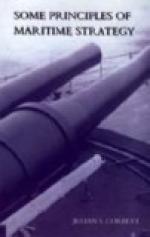NATURE OF ULTERIOR OBJECT
From the nature of the ulterior object we get an important classification of wars, according to whether such object is limited or unlimited.
(1) War with limited object ("limited war”) is where we merely seek to take from the enemy some particular part of his possessions, or interests; e.g., Spanish-American War, where the object was the liberation of Cuba.
(2) War with an unlimited
object is where we seek to overthrow the
enemy completely, so that
to save himself from destruction he must
agree to do our will (become
subservient); e.g., Franco-German War.
NOTE.—Ulterior objects are not necessarily the same in their nature as the immediate (primary or secondary) objects which lead up to them; e.g., ulterior objects may be offensive, while one or more of the immediate objects may be defensive, and vice versa.
EXAMPLE 1.—Japanese position in the late war. Ulterior object of the war (to drive Russians from Manchuria) was offensive (positive). Function or ulterior object of the fleet (to cover the invasion) was defensive (negative). Its primary object to effect this was to attack and destroy the Russian naval force. This was offensive (positive).
EXAMPLE 2.—In the Spanish-American War the ulterior object of the war was (for the Americans) to eject the Spanish Government from Cuba. This was offensive. The ulterior object of the fleet was to prevent the Spaniards sending reinforcements or interfering with the intended American invasion. This was defensive. The primary object of the fleet was to bring the Spanish Fleet to action. This was offensive.
SYSTEM OF OPERATIONS
Having determined the nature of the war by the nature of its object (i.e., whether it is offensive or defensive and whether it is limited or unlimited), strategy has to decide on the system of operations or “plan of the war.”
This depends upon:—
(1) The theatre of the war.
(2) The means at our disposal.
1. Theatre of the War.—Usually defined as “all the territory upon which the hostile parties may assail each other.” This is insufficient. For an island power the theatre of war will always include sea areas. Truer definition: “geographical areas within which lie the ulterior objects of the war and the subordinate objects that lead up to them.”
A “theatre of war” may contain several “theatres of operations.”
2. Theatre of Operations.—Is generally used of the operations of one belligerent only.
An “operation” is any considerable strategical undertaking.
A “theatre of operations” is usually defined as embracing all the territory we seek to take possession of or to defend.




